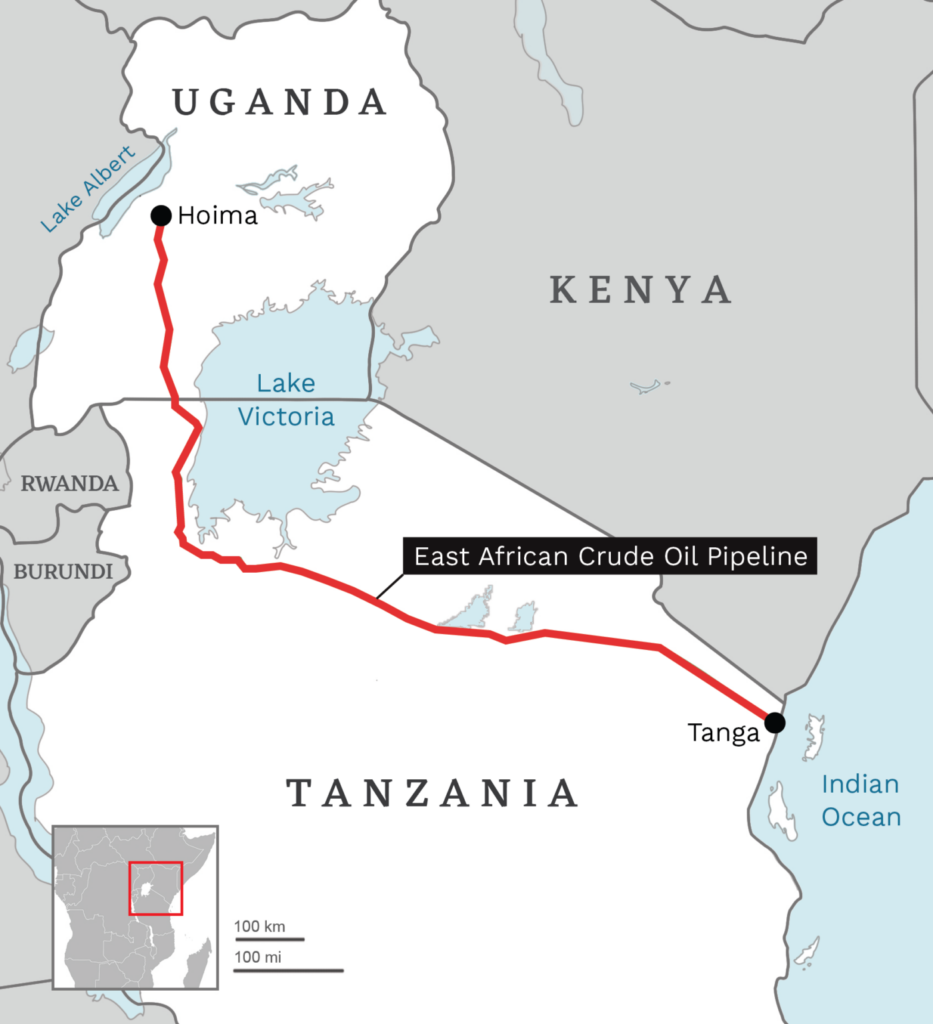Electra Kleitsa
The oil pipeline named EACOP (East Africa Crude Oil Pipeline) is one of the most ambitious projects undertaken by multinational energy companies on the African continent in recent years. It is also a huge threat to local fragile ecosystems and communities in Uganda and Tanzania.
According to the project plan, construction will be completed by 2025 and will consist one of the heated crude oil pipelines in the world, with a total length of 1,443 km. Its estimated cost is 3.8 billion dollars (3.6 billion euros) with the capacity to transport 216,000 barrels of crude oil per day from West Uganda towards the port of Tanga in Tanzania. Once in operation, the pipeline will receive a tariff for each barrel of oil transported.
Uganda’s oil reserves
Oil extraction in North West Uganda has already commenced. However, the goal is for extraction to increase incrementally until it matches the capacity of crude oil capable of being transported via the new pipeline by the time its construction is completed in 2025.

In the mean-time, the works underway, aiming to aid the increased oil extraction are already causing devastating harm to local land used for agriculture in addition to jeopardising wildlife sanctuaries.
The oil reserves, which are estimated at 6.5 billion barrels, are located in the region of Buliisa, only a touch away from Uganda’s Lake Albert. Lake Albert’s water and local biodiversity will from now on be under immediate threat due to the unavoidable oil leaks from the hundreds of wells and smaller pipelines that are under construction in its periphery.
Simultaneously, the French oil giant Total, which has been contracted with building the pipeline, is already displacing locals who live and cultivate the land intended to be used for the EACOP. To this end, the tactics used by Total so far are a shameless combination of inflicting terror on the one hand whilst handing out poor compensations on the other. It is estimated that the works carried out for the extractions will have an impact on over 30,000 civilians in the area, whereas the pipeline itself is threatening to displace at least 13,000 households found on its path in both countries involved. Of note, the works have also been contracted to a Chinese National Offshore Oil Corporation (CNOOC).
According to the environmental organisation ‘Friends of the Earth’, at least 12,000 people will have to give up their land for the sake of the pipeline.
The pipeline
The threat of destruction is not only limited to households and land. In its path, the pipeline will intersect very closely with Lake Victoria, which covers an area of 70,000 km2 and is the second largest freshwater lake in the world. Importantly, the lake’s water, which feeds into the river Nile, is home to more than 200 species of fish and thus, a very important fishing hub for communities based in Uganda, Tanzania and to a lesser extend Kenya.
Overall, it is estimated that the pipeline will threaten the livelihood of tens of thousands of people in the area. In addition to running alongside lake Albert and Lake Victoria, the pipeline will also cross Murchison Falls National Park, an important refuge for elephants, chimpanzees and other wildlife. The construction of a paved roadway used for the transport of materials required for the oil extractions has already been build within the park. The noise disturbance caused by the building of the road per se, in addition to the noise produced by the heavy-duty vehicles crossing has already pushed a large number of animals to abandon the area as their home.
A monstrous gas emission bomb
The dire environmental and societal consequences of extractions and the use of mineral energy are well known. However, there is another, less obvious effect that needs to be discussed and that is the massive release of gas emissions. These are produced not only during the construction of the EACOP but mainly during the transport of the crude oil and its end use by consumers.

According to the Climate Accountability Institute, the pipeline is expected to function for 25 years and during its ‘peak’ will be responsible for double the amount of greenhouse gas emissions produced by Uganda and Tanzania combined, in the year 2020. In fact, the EACOP has been described as a “mid-sized carbon bomb”.
There is a need for movements to grow
The EACOP is an immediate and obvious threat to the environment and the livelihood of the communities in the area and has therefore been greeted with resistance from the get-go. This resistance originates from the locals, who despite being threatened by Total, refuse to abandon their homes. Demonstrations have also been organised by students in Uganda which were greeted with violence and arrests and accompanied by symbolic demonstrations of solidarity across Europe.

These movements are an important starting point, but in order to have the desired effect they must become more massive and properly coordinated. The organized trade unions should organize more pickets and activities to build resistance against the big business that only want to care for their profit while causing environmental degradation. Simultaneous coordinated actions and movements in both Africa and Europe could play an important role in halting the construction of EACOP and help protect some of the last few biodiversity hotspots on the planet.












